DESIGNING DIGITAL AIDS FOR AUTISTIC KIDS: AGHAZ APPLICATION
Methods: Literature Review, Contextual Inquiry, Prototype Building, App Development, User Testing
Project For: Final Year Project for Undergraduate Degree
Advisor: Dr. Suleman Shahid
Project Date: Fall – Spring 2017
1. ABSTRACT
Aghaz is an application that assists autistic children in Pakistan to be better able to learn their native language i.e. Urdu. To come up with the system requirements of the application parents and instructors of autistic children and speech therapist were interviewed. This set of users were then frequently consulted for the design of the application. One component of the system is yet to be integrated but the remaining application is fully functional. This beta version was then used to conduct usability testing with the target audience. This report reflects upon the major parts of the development cycle as well as describes the system architecture.
2. INTRODUCTION
2.1 Motivation
Autism is a complex neuro-developmental condition that typically manifests in the first three years of life. It causes impairment, or differences in three main areas: social understanding, communication and imagination. Autism is a wide spectrum and High-functioning autistic (HFA) is at one end of the Autism Spectrum. HFA has higher IQ but show significant delay in language development. It is estimated that 350,000 children in Pakistan suffer from autism and this number is increasing day by day [1].
Unfortunately, there is very little awareness about autism in Pakistan. The backlash of the ignorance of many people towards autism leads to the child being shunned, and the parents often become discouraged that their child is nothing more than an embarrassment to society. Moreover, very often autism is wrongly diagnosed and Pakistani parent usually label their kids as shy, less talkative and are in state of denial that their child is autistic [2]. Finally, parents, especially with low income and less educated backgrounds, are not ready to accept autism as a disorder and aim at more short-term solutions for improving the socio-emotional behaviour and communication skills of their children with autism [3].
Autistic kids are isolated from the society because of the communication gap and the communication gap exists because they are either non verbal or have articulation issue. Teaching and training of these children requires through professionals and specialized equipment which is largely missing in Pakistan. There is very little work done in Pakistan on language development of these kids and some institutions that do work on it largely work with English language. It is absolutely essential for the autistic kids to be able to communicate in Urdu in order to bridge the gap between them and the society as Urdu is the widely spoken language in Pakistan.
2.2 Project Description and Scope
In order to help autistic children, learn Urdu language and to bridge their social and communication gap the idea of Aghaz application was proposed. Aghaz is an application which teachers/therapists and parents can use to work with their child and help them learn Urdu language. The application is designed in a way so as to progress at the pace of an autistic child with the correct amount of reinforcements as things get integrated.
Moreover, every autistic kid has a different level of understanding and not every child is at the same stage of language development. So the main objective was to keep the application customizable in the aspect that teachers can diagnose and select a level for every child and customize the flow of the course accordingly.
The main stakeholders/users of Aghaz are therapist, parents and autistic children. Aghaz allows more than one user to monitor the profile of a single child i.e. the teacher and parent can simultaneously work with the child. Parents can pick up from where they leave the activity at school or they can help the child reinforce the concepts learned at school. Teacher and parents are also connected through a chat portal where they can divide/assign the work and discuss the progress of the child.
Autism is a wide spectrum and every child is different from the other. Assuming that teachers can better gauge the level of each child and knows his leaning curve better Aghaz gives full authority to the teacher as to how he wants to use the curriculum for the child. There are no pre requisites for any level nor are any requirements to unlock the higher levels. And the progress of each level is monitored separately along with the overall progress of the child.
The curriculum of the application is designed using the current textbooks used at autism schools as well as using the textbooks and curriculum of regular schools. Apart from that language therapy sessions at Autism schools were observed as well as monitored to see how language development is currently focused. Overall curriculum is divided into five categories; flash cards, phonics, word formation, grammar and sentence formation, each category is then subdivided into different activities with reinforcements for each activity.
Digitalising the Urdu whole curriculum is one factor that is unique to Aghaz. There exist other Urdu applications but they don’t go beyond phonics and tracing Urdu alphabets. Also none extensively reinforce the concepts taught. Moreover, the activities or levels in these apps are interlinked they don’t give user the flexibility to teach according to the child’s level given that the target audience in this case is not uniform. Aghaz covers all these shortcomings to provide a one stop solution.
3. LITERATURE REVIEW
3.1 Existing Applications for Autism
Research into assistive devices for autism has targeted mainly progress development and social skill development. Such applications focus very little on concepts of language development and no work has been done to focus on development of Urdu language for autistic.
While doing literature review the applications we looked into included applications for social skill development for autistic, applications to teach Urdu language in general and applications to teach a foreign language.
Following are some examples:
1) Toby: IPad app covering a syllabus of 326 activities across 51 skills known to be deficient for ASD children, such imitation, joint attention and language. The design challenges unique to TOBY are the need to adapt to marked differences in each child’s skills and rate of development (a trait of ASD) and teach parents unfamiliar concepts core to behavioural therapy, such as reinforcement, prompting, and fading [4].
2) LingoKids: Lingokids is the most effective English learning course for kids aged 2-6 featuring content from Oxford University Press. It is a very comprehensive language application. For each concept it has three segments; songs and videos, listening games and my teacher. Its design is really appealing, simple and colourful which increases its efficiency.
3) Avaz: Avaz, a full-featured app, has been developed for children who are non-verbal or who have difficulty speaking. It allows the autistic kid to communicate with others by using images and icons to build a sentence and covey their message.
4) Española-Spanish School Bus: It is an exciting, colourful addictive gameplay to teach basic Spanish vocabulary and aims to inspire a passion for the beautiful Spanish language through introduction of historical figures, landmarks, and catchy songs that kids and parents alike can sing along to. Its reinforcement ideas and games and the way it increases the level of difficulty and reduces prompts in reinforcements is quite effective.
5) Learn Urdu: It is an application of learning Urdu. It gets the user familiar with Urdu alphabets, numbers, vocabulary and a few common sentences, interrogative articles, prepositions, masculine feminine, personal pronouns and nominal sentences.
6) Urdu Qaida: Kids Urdu Qaida Application is to learn and recognize Urdu Language Alphabets and to learn Urdu language in proper pronunciation.
7) There are many other Urdu language offering Urdu alphabet recognition and tracing and correct pronunciation/phonics.
3.2 Gaps in Previous Work
The major concern regarding existing apps is that they are not accessible. Most of the applications are paid which the target user group cannot afford. Secondly, most work has been done on improving social skills of autistic children little has been done for language development.
All the existing Urdu applications are not comprehensive. Mostly only cover the phonics and alphabet tracing. Those which do go further for example Learn Urdu application its curriculum is not interlinked and its just descriptive without any practice exercises. Also all these applications lack the element of progress tracking. Moreover, Applications for language development of autistic kids that do exist are in English. No work locally has been done to enhance language development in Urdu.
Most applications have not designed the activities in sight of the behavioural issues or features of autistic kids which can lead to wrong interpretation or false concepts. For example, in Toby there is an activity to get hands on with the concept of color matching. As a part of the activity child is expected to match the shapes of same color for instance matching a blue star with blue diamond amongst red square and yellow oval. This to much information for the child as he can end up wrongly interpreting that star is same as diamond. So if the aim of the activity is to teach color matching the shapes should have been kept consistent.
Help section for this user group is really critical but the helps or tips sections in many autistic apps are really good in terms of the information shared but they are so lengthy and wordy that the interest is drawn away right after reading a paragraph or two.
4. USER RESEARCH
4.1 Method
Aghaz has mainly 2 user groups; autistic children and therapist/parents.User research for the user group of autistic kids was largely been done previously [3]. For designing the curriculum, language and speech therapists in autism schools and resource canters were interviewed. Moreover, some language therapy sessions at these schools were observed and monitored. This approach was selected to see how therapists currently work on langue development and particularly Urdu language.Moreover, Urdu workbooks used by autism schools were analysed to see how it progresses from one concept to the other. In addition to that workshop on autism skill development were attended to get acquainted with the key behavioural and learning patterns of autistic kids.
4.2 Findings
Major reason which hinders language development is the age factor. Higher the age more difficult it is to develop the language skills of the child. Parents often delay the regulation process. Early intervention thus is really important and for that knowledge of autism and early diagnosis is a must.
Every child lies in different region of the spectrum and accordingly everyone is at different stage of language development. So different strategy for language development is required for different child. Following are the different categories in which the autistic kids can be divided into:
– Non-Verbal: Those children who have difficulty with understanding and speaking.
– Verbal – Inconsistent: Those that m1ay seem fully verbal yet engage in repetitive phrases or sentences (echolalia).
– Verbal – Single word: Those who understand and are able to reply back in one or very few words.
– Verbal Non-Receptive: Those children who may be able to understand simple sentences but are unable to give a reply.
– Verbal Receptive: Those children who are able to understand simple sentences with ease.
– High functioning autistic are mostly verbal but have disordered sentence structure so proper articulation is what is to be focused.
Moreover, most institutes work on the lines of ABLES (Abilities Based Learning and Education Support). ABLES is an assessment tool which helps accurately identify and sets learning goals. How this functions is that ABLES has a list of task and rules in sequence. Therapist ask the child to perform that task. If the child doesn’t respond or is unable to perform that task it is set as one of the targets for the child and therapist works to achieve those targets.
Another major concern is that the outcome of language therapy is unpredictable. Some children respond in weeks and some respond after months. Progress tracking is done after mostly after 6 months to gauge the improvement. For progress tracking their current performance is compared with the initial performance or by running the diagnostic tools again.
One point which every therapist highlighted was that parent’s intervention is really important for significant progress as therapists work on children only twice or thrice the week so for consistency its really important that parents involve in the development process equally and effectively. According to the progress reports from many schools’ parents do honestly play their part and help their child with the homework.
According to the teaching principles, to teach a concept prompting is regulated to ensure child doesn’t depend on it. First physical prompt is given then verbal prompt and then the therapist moves to mouthing and ultimately the child is able to compete the task without any prompts.
Another major finding was the loop hole in the current teaching practices. In one of the language therapy session children were asked to read and English reader. It was a short story with one line descriptions with the images. Children were not good enough at reading the story. Pointing was missing they were not even looking at the reader and would go on repeating the sentences they knew or have learned previously. However, when asked to describe the picture next to the sentence they would do it correctly and effectively but in Urdu.
In one of the sessions conducted with participants they were given a tablet to play a game. In the middle of the game tablet was taken away and the participant was told that he can play again only if he finishes reading a story. While reading participants were not concentrating on the reader at all. They would just turn over the pages in order to finish the story and kept asking for the tablet again and again. This led to the finding that the reward activities should be well monitored and the activities should be equally fun to keep the child engaged.
Another important fact discussed by every therapist was that language development process can fade the language issues but they can’t extinct. This was an important finding from the perspective of clarifying the objective and expectations from Aghaz.
4.3 Requirement Specifications
Users: Therapists and Parents
RQ1: The application will connect parents and teachers/therapists
RQ1a: Both the users can discuss child’s progress
RQ1b: Both the users can view child’s progress
RQ1c: Both the users can monitor child’s activities (synced)
RQ2: One user can simultaneously work with multiple children
RQ2a: Separate list of children for each user
RQ2b: Profile for each child in the list maintained individually
RQ3: User has the flexibility to select the level of curriculum for each child
RQ3a: No pre requisites in the curriculum
RQ3b: Able to go over any level as many times as required
RQ3c: Able to skip the content when required
RQ4: Track the progress of each child
RQ4a: Progress tracking of each level
RQ4b: Progress tracking of each concept
RQ4c: Overall progress tracking of each child
RQ5: Practice exercises to reinforce each concept
RQ5a: Can attempt the exercise as many times as required
RQ5b: Performance for each activity can be tracked
RQ5c: Can skip the exercise if required
RQ5d: Exercise activities can be customized by the user
RQ6: Supports the reward based teaching method
RQ6a: Child get some kind of reward when he performs good in an activity
RQ6b: Rewards can be monitored by the users
RQ6c: Frequency of rewards can be monitored
5. DESIGN
5.1 System Component Diagram

5.2 Screens
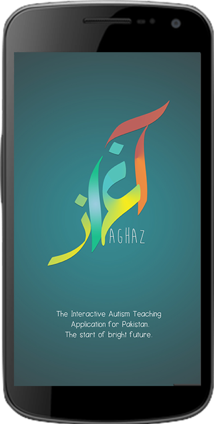


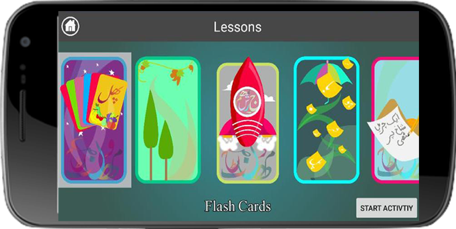
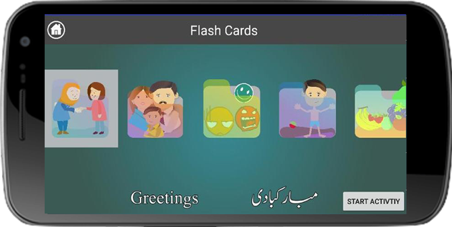
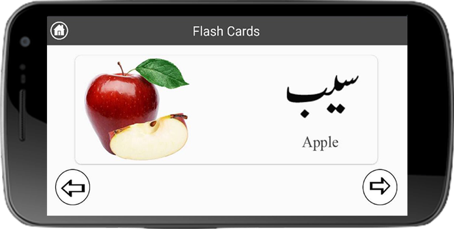
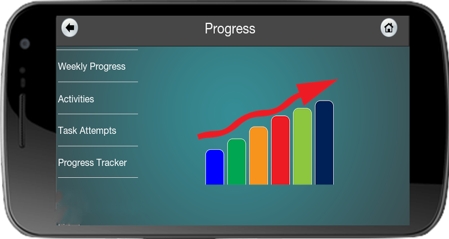

6. DEVELOPMENT
6.1 Features Implemented
1. User Profiles & Dash Board
Aghaz lets a user to sign up as a parent or teacher and the user can then add children to his list. Adding a child creates a separate dashboard for each child with a private chat portal and progress tracker. User can request to add collaborators (parents or other teachers) for a child by generating a unique code which is sent to the collaborator via email.
2. Urdu Curriculum/Lessons
The curriculum is divided into five broad levels based on difficulty and concepts. There are arbitrary number of exercises with in a level including reinforcement exercises along with concept description. Prompting in the exercises is very much monitored. Along with the reinforcements there are fun activities classified as reward after completing a set target to attract and motivate the child.
3. Chat Portal
The aim of this portal is to connect the parent and the teacher so that the two can discuss the progress of the child and homework can be assigned so that parent picks up from where teacher leaves in order to maintain consistency.
4. Help Tool
The help tool is an information tool for parents and teachers. Apart from the help regarding using the application it’ll give visual and textual guide for raising an autistic kid. The information is well chunked and divided into categories and sub categories to avoid wordiness and enable easy read and understanding.
6.2 Database Schema
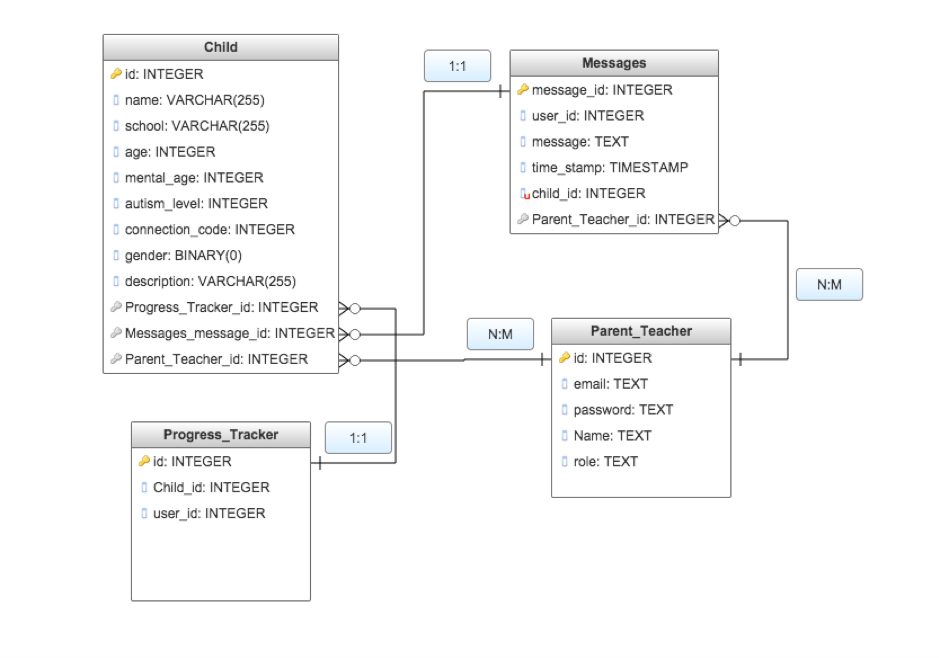
7. TESTING
7.1 Method
Aghaz was tested with the target user group in two phases. In phase one it was tested with autistic children by the researcher. The aim of this test case was to get the direct feedback of the children and to see how they interact with the application and tablet. The users for this case were the children who were somewhat verbal and either currently learning phonics or haven’t started on phonics yet; use flash cards. This testing phase was further divided into two tasks. For each child first they were asked to read the Urdu Qaida; book used to teach phonics and alphabets, until first 8 alphabets and then they were asked to recognize a particular alphabet from the ones he just studied or revised. For the second task they were taught phonics using Aghaz and were asked to attempt the reinforcement exercises that follow up. These tasks were followed by a structured interview of the child. This phase was conducted with 10 participants.
In the second phase teachers were asked to conduct a teaching session with the child using Aghaz followed by a structured interview of the teacher. In this phase use and navigation of the app by the teacher was observed and they were interviewed to figure out in what aspects the app mismatches with their teaching practices. This phase was conducted with 4 participants.
7.2 Results
For the first phase participants (children) preferred studying using Aghaz over their textbook. During task one while they were reading the textbook their concentration span was very less. They would start looking around after reading each letter. However, in case of task two the concentration span was 100%. When questioned about which of the two options; text book or app, they prefer, all the participants replied in favor of the application. One thing that fascinated them the most was the audio of the application. The fact that they could touch and hear the word and then repeat after it and can do it as many times as they want kept them engaged.
However, some loop holes were also pointed out during this process. Some participants said that the voice of the narrator in the app was funny. They would replay it again and again and then laugh. One participant said: “yh larki ha. Wo uncha bolnay ki koshish kr rahi ha isliya mujy hansi arahi ha.” Some even tried to copy the accent of the narrator while repeating after her.
Another important finding was a design flaw in the reinforcements. In the reinforcements when ever child selects the wrong answer that answer shakes/vibrates and the narrator repeats the question again. Some participants were fascinated by the vibration of the image and they would tap on the wrong answer again and again to see that animation.
Moreover, some participants would just skip through the flashcards by taping on the next button again and again. Their actions were needed to be very much monitored for an effective result.
For the second testing phase with the teachers, it was observed that they did not face any difficulty in navigation. The content was really easy for them to teach however they could not rely on the app completely. At some places they had to do the narration themselves to reinforce a concept instead of using the default narration of the application because children would take the teacher more seriously.
Apart from that during the structured interviews teachers highlighted some mismatch in the teaching principles. “Matching is more effective for reinforcement rather than selecting from arbitrary options. This is how we proceed. Matching two same objects/alphabets give the child a better understanding. Recognizing an alphabet, he has learnt amongst other alphabets come last.”
Moreover, while using the app, teachers had questions and answers to all those question were already in the help menu but they didn’t try to use help menu instead they questioned the researcher directly. This emphasized on the need to have popup tutorials on screen to help the user navigate and understand the app easily when he uses it for the first time.
8. DISCUSSION AND CONCLUSION
All the findings from the testing results can be easily addressed to make the app more effective. Participants were concerned about the female voice of the narrator. Initially female voice was chosen because it has a low pitch and so that children can relate it to their teachers (are mostly female) and thus follow the command. This issue however occurred because the recordings were done manually therefore the pitch and tone of the voice was not consistent throughout. It was due to this variation that children found some pronunciations funny and even tried to copy some of them. To make the narration uniform recordings should be edited to align their pitch and frequency.
Another room for improvement is in the reinforcements part. Reinforcements can have levels of difficulty as well. Starting of from the simplest which is content matching it can build up to content recognition in different contexts while also having interactive reinforcements via gamification in between. Further, teachers were more inclined towards the idea of giving them the flexibility to design their own reinforcements. To cater to this requirement some generic images can be made available to the teachers as assets using which they can design their own worksheets if desired.
It was observed that when ever child performed a task right he would look at the teacher anticipating a verbal praise and they would often clap in excitement for themselves as well. The app should thus incorporate this feature as well. In addition to visual praises at the end of each exercise it should have audio praises and cheering sounds in the background when ever the child answers right in order to motivate him.
The major component of Aghaz yet to be implemented is the progress tracker. According to the results of interviews conducted with the teacher’s progress should be monitored at different levels and that can be used to interpret the overall progress. Different parameters of measuring progress include: number of attempts while answering reinforcement, number of times reinforcements attempted and daily, weekly and monthly progress in terms of curriculum. Another effective feature could be to have a daily reinforcement activity selected from the concepts previously learned before the child progresses with the curriculum, each day.
Testing done so far is not extensive enough to prove the effectiveness of the application because there existed a bias due to novelty factor and because only one session was conducted. For proper evaluation of the app proper testing plan is to be laid out with at least 3 sessions a week with same group of participants for at least 4 weeks, once the progress tracker is implemented.
Although evaluation of the application was not comprehensive still the beta version of the application did receive a positive response from all stake holders. The Urdu curriculum and the way its segmented and integrated in the application is what sets it apart and makes it a positive contribution. In future giving more flexibility to teachers on the part of reinforcement activities and integrating automatic progress tracking will make the system more effective.